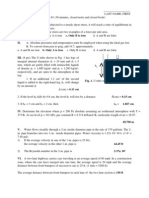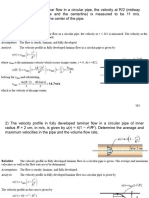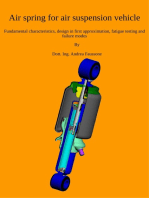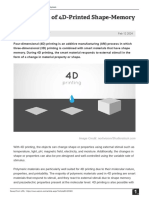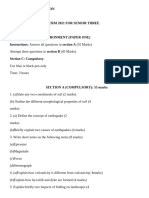Tutorial Problems Integral Approach
Uploaded by
Nabayan SahaTutorial Problems Integral Approach
Uploaded by
Nabayan SahaTutorial Problems on Integral Momentum Balance
Y
1. The diameter of a pipe bend is 30 cm at inlet and 15 cm at outlet
and the flow is turned through 1200 in a vertical plane. The axis V1
P1
Z1 X
o
at inlet is horizontal and the centre of the outlet section is 1.5 m 120
below the centre of the inlet section. Total volume of water in the 1
bend is 0.9 m3. Neglecting friction, calculate the magnitude and
direction of the force exerted in the bend by water flowing
through it at 250 L/s and when the inlet pressure is 0.15 N/mm2 Z2
(Note that the pressure at the inlet is absolute pressure and the 2
outlet is not open to the atmosphere). V2 , P2
2. The figure represents flow of gasoline (of specific gravity equal
to 0.72) through a reducer of weight 25 kg and total volume equal
to 0.2 m 3. The velocity at the inlet od diameter equal to 0.4 m is
3 m/s and at the outlet is 12 m/s. The pressure at the inlet is 58.7
kPa (gage) and at the outlet is 109 kPa (absolute). Calculate the
force needed to hold the reducer in place.
1 2
3. A conical spray head is shown in the figure. The fluid is water and
the exit stream is uniform along the entire inner surface of the spray
head. Evaluate (a) the thickness of the water film along the spray
head, when the radius of the spray head is 400 mm, and (b) the axial
force exerted by the spray head on the connecting supply pipe.
4. A horizontal, axi-symmetric jet of air (ρ = 1.23 Kg/m3) with a diameter
of 10 mm strikes the centre of a vertical disk of 200 mm diameter. The
jet speed is 50 m/s at the nozzle exit. There is a small hole at the centre
of the disk, where the air jet strikes and a manometer with a manometric
liquid of specific gravity equal to 1.75. Calculate (i) the deflection, h,
of the manometer and (ii) the force exerted by the jet on the disk.
5. Water at 45 oC enters a shower head through a circular tube with 15.8 mm inside diameter. The
water leaves in 24 streams, each of 1.05 mm diameters. The volume flow rate is 5.67 L/min.
Estimate
(i) The minimum water pressure needed at the inlet to the
shower head.
(ii) Force needed to hold the shower head onto the end of the
circular tube. You may use the value of the contraction
coefficient, K, to be equal to 0.5, = 990 kg/m3. The
frictional losses are generally small for such short lengths
associated with the shower head.
You might also like
- CIQA PQ Template Protocol Lyophilization Process Sample Version100% (2)CIQA PQ Template Protocol Lyophilization Process Sample Version3 pages
- Tutorial Problems Integral Approach and Bernoulli EquationNo ratings yetTutorial Problems Integral Approach and Bernoulli Equation2 pages
- Tutorial Problems Integral Approach and Bernoulli EquationNo ratings yetTutorial Problems Integral Approach and Bernoulli Equation2 pages
- Department of M Echanical and Industrial Engineering M I 205: Fluid M Echanics Tutorial 5No ratings yetDepartment of M Echanical and Industrial Engineering M I 205: Fluid M Echanics Tutorial 51 page
- Fluid Mechanics Assignment-5 (Momentum Conservation) : Aditya BandopadhyayNo ratings yetFluid Mechanics Assignment-5 (Momentum Conservation) : Aditya Bandopadhyay9 pages
- CL 254: Process Fluid Mechanics 2022 (S1) Tutorial 2: Due Date - 24 Jan 2022, 23:59No ratings yetCL 254: Process Fluid Mechanics 2022 (S1) Tutorial 2: Due Date - 24 Jan 2022, 23:592 pages
- Unit-Iii FLUID DYNAMICS: Surface and Body Forces, Concepts of Fluid System and50% (2)Unit-Iii FLUID DYNAMICS: Surface and Body Forces, Concepts of Fluid System and23 pages
- FLUID I CH 5 Fluid Dynamics Analysis Control Volume Tut 5No ratings yetFLUID I CH 5 Fluid Dynamics Analysis Control Volume Tut 59 pages
- 15A01510 Fluid Mechanics and Hydraulic MachinesNo ratings yet15A01510 Fluid Mechanics and Hydraulic Machines2 pages
- Assignment 2012 2nd Year Mechanical EngineeringNo ratings yetAssignment 2012 2nd Year Mechanical Engineering17 pages
- Institute Open Elective Course Fluid Mechanics (CHO 102) Assignment IIINo ratings yetInstitute Open Elective Course Fluid Mechanics (CHO 102) Assignment III2 pages
- Suggestions For External Examination - Fluid MechanicsNo ratings yetSuggestions For External Examination - Fluid Mechanics6 pages
- National University of Singapore Department of Mechanical Engineering ME 2134-Fluid Mechanics: PART 2 (2017) (Tutorial Sheet 2)No ratings yetNational University of Singapore Department of Mechanical Engineering ME 2134-Fluid Mechanics: PART 2 (2017) (Tutorial Sheet 2)5 pages
- Lecture - 07 - Linear Momentum Equation and Its Applications-ProblemsNo ratings yetLecture - 07 - Linear Momentum Equation and Its Applications-Problems20 pages
- APL107: Fluid Mechanics Tutorial Sheet #3: Integral AnalysisNo ratings yetAPL107: Fluid Mechanics Tutorial Sheet #3: Integral Analysis3 pages
- Cylindrical Compression Helix Springs For Suspension SystemsFrom EverandCylindrical Compression Helix Springs For Suspension SystemsNo ratings yet
- Applications of 4D Printed Shape Memory PolymersNo ratings yetApplications of 4D Printed Shape Memory Polymers4 pages
- Ebook 35 Resume Mistakes by Alex BERGHOFEN 2023-02-12No ratings yetEbook 35 Resume Mistakes by Alex BERGHOFEN 2023-02-1233 pages
- Self sensing concrete in smart structures 1st Edition Baoguo Han - Download the ebook today and own the complete content100% (2)Self sensing concrete in smart structures 1st Edition Baoguo Han - Download the ebook today and own the complete content65 pages
- A Study On Green Banking in India - An: Commerce Original Research PaperNo ratings yetA Study On Green Banking in India - An: Commerce Original Research Paper3 pages
- narrative techniques class 12 by taniyaNo ratings yetnarrative techniques class 12 by taniya17 pages
- Business Negotiations - Unit 1 - Business Negotiations Week-1 QUIZ ANSWERSNo ratings yetBusiness Negotiations - Unit 1 - Business Negotiations Week-1 QUIZ ANSWERS3 pages
- Week Two Homework Problem Solutions: Fundamentals of ! Fluid PowerNo ratings yetWeek Two Homework Problem Solutions: Fundamentals of ! Fluid Power6 pages
- Geography Physical and Human Exam of The Third Term 2021 For s3No ratings yetGeography Physical and Human Exam of The Third Term 2021 For s321 pages
- Simultaneous Sorting of Wavelengths and Spatial Modes Using Multi-Plane Light ConversionNo ratings yetSimultaneous Sorting of Wavelengths and Spatial Modes Using Multi-Plane Light Conversion6 pages
- Foundation Drawings-2: 8 Thick Polymer Cement Mortar Waterproof LayerNo ratings yetFoundation Drawings-2: 8 Thick Polymer Cement Mortar Waterproof Layer1 page
- Maize mid-density genotyping services _ ExcellenceinbreedingNo ratings yetMaize mid-density genotyping services _ Excellenceinbreeding4 pages
- Determine How Energy Flows in An Energy Pyramid (883) Student 08062024No ratings yetDetermine How Energy Flows in An Energy Pyramid (883) Student 080620249 pages
- Faktor-Faktor Risiko Kejadian Bayi Berat Badan Lahir Rendah (BBLR) Di Wilayah Kerja Puskesmas Pelaihari Tahun 2015No ratings yetFaktor-Faktor Risiko Kejadian Bayi Berat Badan Lahir Rendah (BBLR) Di Wilayah Kerja Puskesmas Pelaihari Tahun 20158 pages
- International Journal of Solids and Structures: L. Wu, L. Noels, L. Adam, I. DoghriNo ratings yetInternational Journal of Solids and Structures: L. Wu, L. Noels, L. Adam, I. Doghri18 pages


































